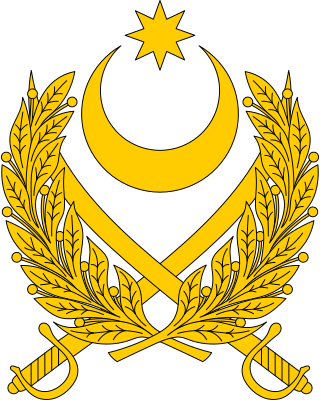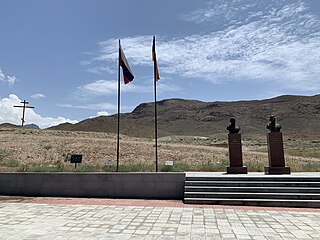
The Azerbaijani Armed Forces is the military of the Republic of Azerbaijan. It was re-established according to the country's Law of the Armed Forces on 9 October 1991. The original Azerbaijan Democratic Republic's armed forces were dissolved after Azerbaijan was absorbed into the Soviet Union as the Azerbaijan Soviet Socialist Republic from 28 April 1920. After the Soviet Union dissolved in 1991–92, Azerbaijan's armed forces were reformed based on Soviet bases and equipment left on Azerbaijani soil.

The First Nagorno-Karabakh War was an ethnic and territorial conflict that took place from February 1988 to May 1994, in the enclave of Nagorno-Karabakh in southwestern Azerbaijan, between the majority ethnic Armenians of Nagorno-Karabakh backed by Armenia, and the Republic of Azerbaijan with support from Turkey. As the war progressed, Armenia and Azerbaijan, both former Soviet republics, entangled themselves in protracted, undeclared mountain warfare in the mountainous heights of Karabakh as Azerbaijan attempted to curb the secessionist movement in Nagorno-Karabakh.

The Armenian Air Force is the air arm of the Armed Forces of Armenia formed by independent Armenia in 1992 in the wake of the dissolution of the Soviet Union. Outside its conventional name, it has also been referred to as the Aviation Department of the Armenian Armed Forces. It is organized and equipped principally to provide Armenian ground forces with tactical air support in the form of ground attack and airlift in mountainous terrain. It provided effective support during the battles with Azerbaijan in the Nagorno-Karabakh region from 1992 to 1994.
Ganja International Airport is an airport serving Ganja, the second-largest city in Azerbaijan.

Karakend, or Berdashen (Armenian: Բերդաշեն, lit. 'village of the fortress' is a village in the Khojavend District of Azerbaijan, in the disputed region of Nagorno-Karabakh.

Stepanakert Airport or Khojaly Airport is an airport in the town of Khojaly, 10 kilometers north-east of Stepanakert, Azerbaijan. The airport, in the Nagorno-Karabakh region, had been under the control of the self-proclaimed Republic of Artsakh from 1992 to 2023. Flights ceased with the escalation of the First Nagorno-Karabakh War in 1990.

The 1994 Iranian Air Force C-130 shootdown occurred on March 17, 1994, when an Iranian Air Force C-130E military transport aircraft, carrying Iranian embassy personnel from Moscow to Tehran, was shot down by Armenian military forces near the city of Stepanakert in Nagorno-Karabakh, an area which had been under armed conflict since 1988. The 32 people on board were killed in the crash.

On November 20, 1991, an Azerbaijani Mil Mi-8 military helicopter, carrying a peacekeeping mission team consisting of 13 Azerbaijani government officials, two Russian and one Kazakhstani Ministry of Internal Affairs officials, three Azerbaijani journalists and three helicopter crew was shot down amidst heavy fighting near the village of Berdashen, also known as Karakend, in Nagorno-Karabakh. All 22 people on board were killed in the crash. The incident is known in Azerbaijan as the ''Karakend tragedy''.

The siege of Stepanakert started in late 1991, during the First Nagorno-Karabakh War, in Stepanakert, the largest city in Nagorno-Karabakh, when the Azerbaijani forces circled the city. Until May 1992, the city and its Armenian population were the target of a months-long campaign of bombardment by Azerbaijan. The bombardment of Stepanakert and adjacent Armenian towns and villages, which took place under the conditions of total blockade by Azerbaijan, caused widespread destruction and many civilian deaths.

On 12 November 2014, an Armenian Mil Mi-24 attack helicopter was shot down by Azerbaijani Armed Forces during the Nagorno-Karabakh conflict, killing all three crew members.

Safa Fatulla oghly Akhundov was the National Hero of Azerbaijan and warrior during the First Nagorno-Karabakh War.

Arastun Ispandi oghlu Mahmudov was the National Hero of Azerbaijan and warrior during the First Nagorno-Karabakh War.
Hikmat Oktay oghlu Muradov was the National Hero of Azerbaijan and warrior during the First Nagorno-Karabakh War.
Viktor Vasilyevich Seryogin was the National Hero of Azerbaijan and warrior during the First Nagorno-Karabakh War.
The casualties of the Second Nagorno-Karabakh War, fought between Armenia, the self-proclaimed Republic of Artsakh and Azerbaijan, officially number in the low thousands. According to official figures released by the belligerents, Armenia and Artsakh lost 3,825 troops, with 187 servicemen missing in action, while Azerbaijan lost 2,906 troops, with 6 missing in action. The Syrian Observatory for Human Rights reported the deaths of 541 Syrian fighters or mercenaries fighting for Azerbaijan. However, it is believed that the sides downplayed the number of their own casualties and exaggerated the numbers of enemy casualties and injuries.

The 2020 shelling of Ghazanchetsots Cathedral took place prior to the Battle of Shusha on 8 October, when the Holy Savior Cathedral of the city of Shusha, known as Ghazanchetsots Cathedral, was struck twice by missiles, resulting in the collapse of a part of the roof. Armenia accused the Azerbaijani Armed Forces over the shelling.

The Battle of Shusha was a battle fought between the armed forces of Azerbaijan and the self-proclaimed Republic of Artsakh, militarily supported by Armenia, over the control of the city of Shusha, during the Second Nagorno-Karabakh War. The battle is considered one of the bloodiest battles of the war.

On 9 November 2020, a Russian Mil Mi-24 helicopter was shot down by the Azerbaijani Armed Forces during the Second Nagorno-Karabakh War. It was shot down near Yeraskh, in Armenia, a few kilometers away from Azerbaijan's Nakhchivan Autonomous Republic, as a result of fire from the ground from man-portable air-defense system. Two of the crew members died, while another was injured as a result of the attack. Azerbaijani authorities soon issued a statement of apology, saying that the shootdown happened by mistake and offered compensation.
Because of the geography, history, and sensitivities of the Nagorno-Karabakh conflict, accusations, allegations, and statements have been made of involvement by third-party and international actors during the Second Nagorno-Karabakh War, including in media reports. Azerbaijan has been accused of employing Syrian mercenaries during the war, including reports by the Syrian Observatory for Human Rights (SOHR). There have also been allegations of Kurdish militia from Syria and Iraq fighting on the Armenian side, and although some third-party sources had confirmed it, some publications had considered these claims "dubious". During the war, ethnic Armenian volunteers from the Middle East, Europe, and Latin America fought on Armenian side. Both sides have denied employing mercenaries in the war, but the OHCHR had stated that there were reports about Syrian fighters motivated primarily by private gain fighting on Azerbaijan's side recruited with Turkey's assistance and foreign nationals fighting on Armenian side with motivation being investigated, calling for withdrawal of any mercenaries and related actors from Nagorno-Karabakh.














